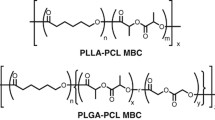Abstract
Cell adhesion, cell growth and cell activities of macrophages and fibroblasts, cultured on newly developed degradable multiblock-copolyesters were studied to examine the biocompatibility and the possible use of these polymers for medical applications. The biocompatibility and the biodegradability of the polymers were confirmed by subcutaneous implantation of polymer foils in rats.
The newly developed polymers, two polyesters (DegraPol/bsc43 and DegraPol/bsd43) and a polyesterether (DegraPol/bst41), were found to exhibit good cell compatibility; the cell-to-substrate interactions induced neither cytotoxic effects nor activation of macrophages.
The adhesion and growth of fibroblasts and macrophages were different among the substrate. Fibroblasts adhered on the polyesters to about 60% of control cell cultured on tissue culture polystyrene (TCPS) and proliferated in the same doubling time as on TCPS. On the polyetherester cells exhibited weak adhesion; however, they proliferated up to day 4 after plating at the same doubling time as on TCPS (of about 42 h), and then decreased their doubling time to 27 h. Macrophages attached to the polyesters to about 40–60% of TCPS but no significant change was seen in the doubling time of cells cultured on TCPS and the polyesters. Again on the polyetherester, macrophages exhibited relatively low adhesion (25% of TCPS) and high doubling time (about 100 h).
Fibroblasts produced high amounts (up to 500% of control cells) of collagen type I and type IV, and fibronectin. Macrophages responded to lipopolysaccharide treatment by the production of nitric oxide (NO) and tumour necrosis factor-α (TNF-α), indicating that the cell-to-polymer interactions allow fibroblasts and macrophages to maintain their phenotype.
All three test polymers exhibit favourable tissue compatibility. The formed capsule was just a few cell layers thick (<30 μm). After 2 months implanted subcutaneously in rats, the molecular weight of the test polymers was reduced by >20% depending on their chemical structure.
Taken collectively, the present data demonstrate that the newly developed multiblock copolyesters are biocompatible and biodegradable.
Similar content being viewed by others
References
S. DUMITRIU, “Polymeric biomaterials”, edited by S. Dumitriu (M. Dekker, New York, 1994).
J. M. ANDERSON, Cardiovasc. Pathol. 2 (1993) 33.
G. J. DARLINGTON, D. R. WILSON and B. LACHMAN, J. Cell Biol. 103 (1986) 787.
P. M. CALLERY, T. KAMEI and M. W. FLYE, Circ. Shock 37 (1992) 185.
Y. TABATA and Y. IKATA, Adv. Polym. Sci. 94 (1990) 108.
M. VERT, P. CHRISTEL and F. CHABOT, in “Macromolecular biomaterials”, edited by C. W. Hastings and P. Ducheyene (CRC Press, Boca Raton, FL, 1984).
P. CHRISTEL, F. CHABOT and M. VERT, in Proceedings of the 2nd World Congress on Biomaterials, edited by J. M. Anderson (Society of Biomaterials, 1984) p. 279.
P. ROKKANEN, O. BOSTMAN, S. VAINIONPAA, K. VITHONEN, P. TORMALA, J. LAIHO, J. KILPIKARI and M. TAMMINMAKI, Lancet 1 (1985) 1442.
M. BERCOVY, D. GOUTALLIER, M. C., VOISIN, D. GEIGER, D. BLANQUAERT, A. GAUDICHET and D. PATTE, Clin. Orthop. 159 (1985).
D. K. GILDING and A. M. REED, Polymer 20 (1979) 1459.
Y. IMAI, in “Biomedical applied polymer materials”, edited by T. Tsuruta, T. Hayashi, K. Kataoka, K. Ishihara and Y. Kimura (CRC Press, Boca Raton, FL, 1993) p. 54.
O. M. KEISER, P. NEUENSCHWANDER and U. W. SUTER (1996) in preparation.
T. D. HIRT, P. NEUENSCHWANDER and U. W. SUTER, Macromol. Chem. Phys. 197 (1996) 1609.
B. SAAD, G. CIARDELLI, S. MATTER, M. WELTI, G. K. UHLSCHMID, P. NEUENSCHWANDER and U. W. SUTER, J. Biomed. Mater. Res. 30 (1996) 429.
A. H. DING, C. F. NATHAN and D. J. STUEHR, J. Immunol. 141 (1988) 2407.
T. ESPEVIK and J. NISSEN-MEYER, J. Immunol. Methods 95 (1986) 99.
M. M. BRADFORD, Anal. Biochem. 72 (1976) 248.
B. SAAD, F. A. SCHOLL, H. THOMAS, H. P. SCHAWALDER, V. STREIT, F. WAECHTER and P. MAIER, Eur. J. Biochem. 213 (1993) 805.
G. M. EDELMAN, B. A. CUNNINGHAM and J. P. THIERY, “Morphoregulatory molecules” (Wiley, New York, 1990) p. 1.
F. GRINNELL, in “Growth and maturation factors”, edited by G. Guroff (John Wiley, New York, 1983).
S. H. ALBELDA and C. A. BUCK, FASEB J. 4 (1990) 2868.
E. G. HAYMAN, M. D. PIERSBACHER, Y. OHGREN and E. ROUSLATHI, Proc. Natl Acad. Sci. USA 80 (1983) 4003.
C. M. CUNANAN, N. M. TARBAUX and P. M. KNIGHT, J. Cataract Refract. Surg. 17 (1991) 767.
Y. TAMADA and Y. IKADA, J. Biomed. Mater. Res. 28 (1994) 783.
Author information
Authors and Affiliations
Rights and permissions
About this article
Cite this article
SAAD , B., KEISER , O.M., WELTI , M. et al. Multiblock copolyesters as biomaterials: in vitro biocompatibility testing. Journal of Materials Science: Materials in Medicine 8, 497–505 (1997). https://doi.org/10.1023/A:1018582311361
Issue Date:
DOI: https://doi.org/10.1023/A:1018582311361




